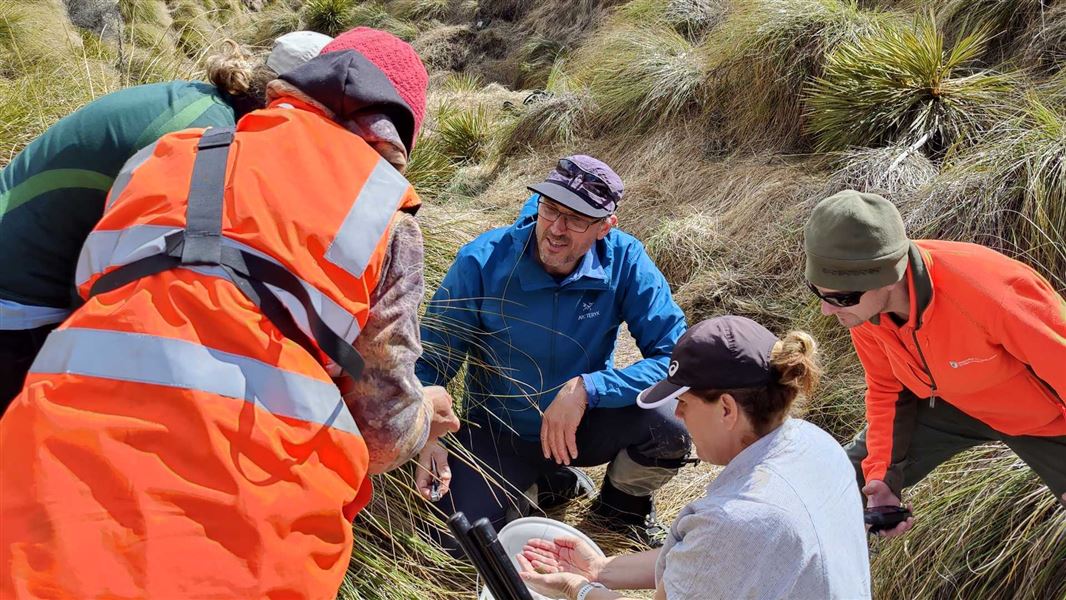Archived content: This media release was accurate on the date of publication.
Date: 18 April 2023
“Central Otago is the proud home to numerous galaxiid species that are found nowhere else in the world,” DOC River Ranger Chris Kavazos says.
“Unfortunately, Clutha flatheads are one of the most endangered galaxias because of trout predation and habitat loss. They share the same threat status as kākāpō.
“Given the threats these fish face, it’s amazing to discover a new population. Now it’s on us to ensure it survives.”
Chris says DNA technology is a game changer for conservation work, helping to detect elusive species. Clutha flatheads are difficult to spot as they camouflage with gravels and cobbles in waterways.
“We were surveying the upper Cardrona Valley for Clutha flatheads in late 2021. This involved taking an eDNA (environmental DNA) sample in the lower Tyre Gully, which is on public conservation land.
“From the water sample we detected the presence of Clutha flatheads up to 5km upstream.”
Chris has done follow-up surveys of Tyre Gully and reckons its Clutha flathead population is in the hundreds.
“The Tyre Gully population has healthy numbers compared to neighbouring waterways which probably have only a handful of adults.
“It turned out a small waterfall in Tyre Gully was the only thing stopping trout downstream from migrating up and predating the flatheads.
“However, future flood events could make the waterfall useless as a trout barrier, meaning we could lose the entire Tyre Gully flathead population overnight.
“The removal of trout downstream is already underway and will offer better protection for the population in the long term.”
Chris says better barriers are helping too. WAI Wānaka, a driving force behind freshwater restoration efforts in the Cardrona Valley, have collaborated with Otago Polytechnic on a movable, adjustable fish passage barrier currently in use at Tyre Gully.
“All this work will increase the habitat available to flatheads, allowing re-occupation of habitats lost through trout predation.”
Chris emphasises that trout in Tyre Gully aren’t part of the recreation fishing network as they’re small and not trophy fish. They also don’t breed into any recreational fishing networks.
“Clutha flatheads are still dangerously close to extinction, but we now have the chance to save a population that could have become extinct without us knowing it was ever there.”
Paulette Tamati-Elliffe of te Rūnanga o Ōtākou, says the mauri of the Cardrona Valley’s waterways has been diminished with loss of taoka species, but the discovery of Clutha flatheads gives hope that mauri can be restored.
“By removing introduced species, Clutha flatheads are given a fighting chance to survive and even thrive.”
Cardrona Valley freshwater restoration efforts will continue to be a collaborative effort between WAI Wānaka, DOC, Otago Regional Council and Otago Fish & Game, with scope for the wider community involvement thanks to WAI Wānaka’s efforts.
WAI Wānaka Partnerships Manager Julie Perry says the group recently received funding for its ‘Taking care of Tyre Gully’ project from the WWF Conservation Fund.
“This project provides opportunities for everyone to learn about the Tyre Gully Clutha Flathead population and even play a direct role in restoration efforts.”
Background
eDNA detection involves collecting samples of the environment such as water or soil.
In this case, Chris put an eDNA sampler at the foot of Tyre Gully that concentrated DNA into a filter. This sample was then sent to Wilderlab NZ Ltd, for sequencing to determine the identity of freshwater species living in the waterway.
Contact
For media enquiries contact:
Email: media@doc.govt.nz
